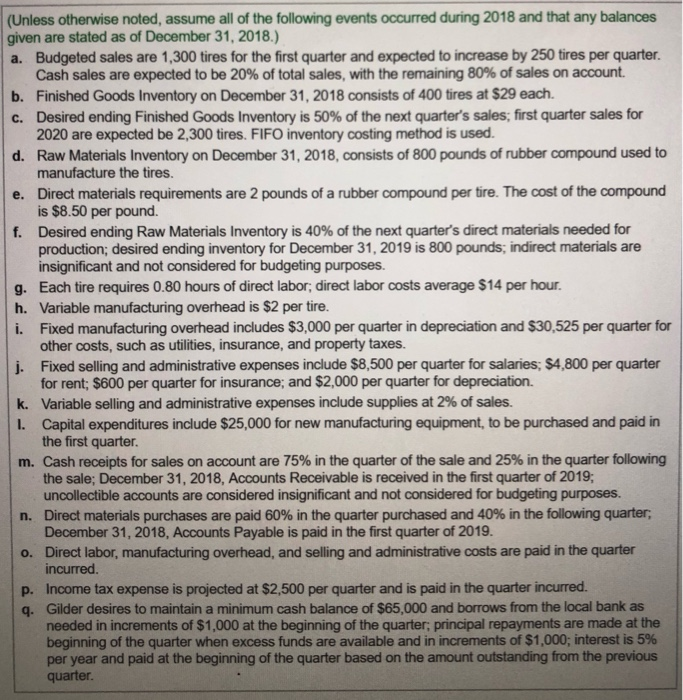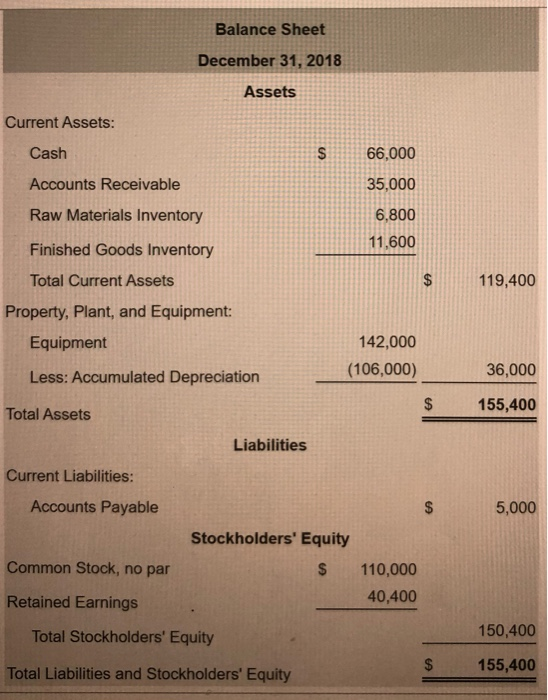Click the icon to Vow the balance sheet.) Reduwe Requirement 1. Prepare Gilder's operating budget and cash budget for 2019 by quarter. Required schedules and budgets include: sales budget, production budget direct materials budget, direct labor budget, manufacturing overhead budget, cost of goods sold budget, selling and administrative expense budget, schedule of cash receipts, schedule of cash payments, and cash budget. Manufacturing overhead costs are allocated based on direct labor hours. Round all calculations to the nearest dollar Begin by preparing the sales budget. (Unless otherwise noted, assume all of the following events occurred during 2018 and that any balances given are stated as of December 31, 2018.) a. Budgeted sales are 1,300 tires for the first quarter and expected to increase by 250 tires per quarter. Cash sales are expected to be 20% of total sales, with the remaining 80% of sales on account, b. Finished Goods Inventory on December 31, 2018 consists of 400 tires at $29 each. c. Desired ending Finished Goods Inventory is 50% of the next quarter's sales; first quarter sales for 2020 are expected be 2,300 tires. FIFO inventory costing method is used. d. Raw Materials Inventory on December 31, 2018, consists of 800 pounds of rubber compound used to manufacture the tires. e. Direct materials requirements are 2 pounds of a rubber compound per tire. The cost of the compound is $8.50 per pound. f. Desired ending Raw Materials Inventory is 40% of the next quarter's direct materials needed for production; desired ending inventory for December 31, 2019 is 800 pounds; indirect materials are insignificant and not considered for budgeting purposes. g. Each tire requires 0.80 hours of direct labor; direct labor costs average $14 per hour. h. Variable manufacturing overhead is $2 per tire. i. Fixed manufacturing overhead includes $3,000 per quarter in depreciation and $30,525 per quarter for other costs, such as utilities, insurance, and property taxes. j. Fixed selling and administrative expenses include $8,500 per quarter for salaries; $4,800 per quarter for rent; $600 per quarter for insurance; and $2,000 per quarter for depreciation. k. Variable selling and administrative expenses include supplies at 2% of sales. 1. Capital expenditures include $25,000 for new manufacturing equipment, to be purchased and paid in the first quarter. m. Cash receipts for sales on account are 75% in the quarter of the sale and 25% in the quarter following the sale; December 31, 2018, Accounts Receivable is received in the first quarter of 2019; uncollectible accounts are considered insignificant and not considered for budgeting purposes. n. Direct materials purchases are paid 60% in the quarter purchased and 40% in the following quarter, December 31, 2018, Accounts Payable is paid in the first quarter of 2019. o. Direct labor, manufacturing overhead, and selling and administrative costs are paid in the quarter incurred. p. Income tax expense is projected at $2,500 per quarter and is paid in the quarter incurred. q. Gilder desires to maintain a minimum cash balance of $65,000 and borrows from the local bank as needed in increments of $1,000 at the beginning of the quarter, principal repayments are made at the beginning of the quarter when excess funds are available and in increments of $1,000; interest is 5% per year and paid at the beginning of the quarter based on the amount outstanding from the previous quarter. Balance Sheet December 31, 2018 Assets Current Assets: Cash Accounts Receivable Raw Materials Inventory 66,000 35,000 6,800 11,600 119,400 Finished Goods Inventory Total Current Assets Property, Plant, and Equipment: Equipment Less: Accumulated Depreciation 142,000 (106,000) 36,000 155,400 Total Assets Liabilities 5,000 Current Liabilities: Accounts Payable Stockholders' Equity Common Stock, no par $ Retained Earnings Total Stockholders' Equity 110,000 40,400 150,400 Total Liabilities and Stockholders' Equity $ 155,400









